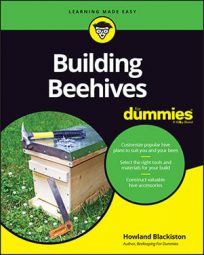A screened bottom-board really helps with mite control in your bee hive, and you find out how to build one here. With varroa mites a problem for many beekeepers, screened bottom-boards are gaining popularity. Here’s how a screened bottom-board works: A moderate number of mites naturally fall off the bees each day and land on the bottom-board of the hive.
Ordinarily, they would just crawl back up and reattach themselves to the bees, but not when you use a screened bottom-board in place of a regular bottom-board. Mites drop off the bees and either fall to the ground or are trapped on the sticky inspection board placed under the screening. Either way, they’re unable to crawl back up into the hive.
When using an inspection board, you can actually count the number of mites that have fallen off the bees and thus monitor the mite population and take action when required.
![[Credit: Illustration by Felix Freudzon, Freudzon Design]](https://www.dummies.com/wp-content/uploads/357131.image0.jpg)
Vital stats for an IPM screened bottom-board
Size: 22 inches x 16-1/4 inches x 1-7/8 inches.
Capacity: You need to build one screened bottom-board for each hive in your apiary.
Universality: The dimensions of this design are intended for use with the Langstroth hive. However, if you modify your measurements a little, a version of this will also do nicely with the nuc hive, the Warré hive, or the British National hive.
Degree of difficulty: This board is likely one of the easiest projects in this book; it’s no more involved than making a standard bottom-board.
Cost: As with any hive parts, using scrap wood would keep material costs minimal. But even if you purchase the recommended knotty pine, hardware, and fasteners, you can likely build a screened bottom-board for less than $20.
Materials list for an IPM screened bottom-board
The following table lists what you’ll use to build your IPM screened bottom-board. In most cases, you can make substitutions as needed or desired.
| Lumber | Hardware | Fasteners |
|---|---|---|
| 1, 6' length of 1" x 5" knotty pine lumber | 1-1/2 yards 2-ply nylon string/twine (you’ll likely have to purchase a roll of this stuff) | 12, #6 x 1-3/8" deck screws, galvanized, #2 Phillips drive, flat-head with coarse thread and sharp point |
| 1/8" (#8) hardware cloth (typically comes in 3' wide and 10’ long rolls, but some beekeeping supply vendors sell it by the foot) | 14, 5/32" x 1-1/8" flat-head, diamond-point wire nails | |
| White Plasticor corrugated board (available at art supply stores in various sizes). Make sure you order a piece that will allow you to wind up with board that’s 22" x 14" x 3/16" | 24, 3/8" staples for use in a heavy-duty staple gun | |
| Optional: weatherproof wood glue | ||
| Optional: a pint of latex or oil exterior paint (white or any light color), exterior polyurethane, or marine varnish |
Here are a few tips for purchasing materials for your IPM screened bottom-board:
Use knotty pine for a screened bottom-board because it’s easy to find and inexpensive. A more durable choice (but a bit more expensive) is cedar or cypress (both of which are very weather-resistant).
In the materials list, there are a few more fasteners than you’ll need just in case you lose a few along the way. It’s better to have a few extras on hand and save another trip to the hardware store.
Each hive in your apiary can use one screened bottom-board. If you have a couple of hives that need boards, just double everything in the preceding table to build a couple of boards.

